 |
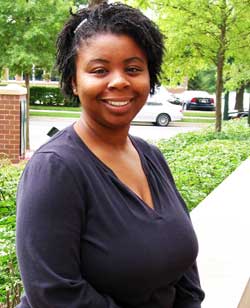
|
|
Keisha Hines-Harris, Biological Technician, Sequencing Production Technician, National Intramural Sequencing Center, National Human Genome Research Institute, NIH
|
1. I chose this career because...
2. My typical workday involves...
3. What I like best/least about my work...
4. My career goals...
5. When I'm not working, I like to...
6. Choosing my own path...
|
|
1. I chose this career because...
|
Back to Top

|
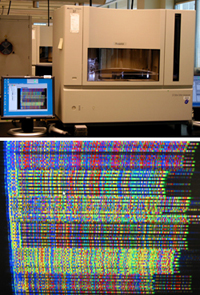
|
|
Keisha uses an automated sequencing robot, the Applied Biosystems 3730 DNA Analyzer (top) that transfers the sequence data to a monitor she can view (bottom).
|
I chose to become a biological technician because no other career choice ever peaked my interest. The classes that interested me most and that I performed well in were biology, environmental science, and mathematics. My dad was an engineer and my mom is a nurse; so I was put on a scientific path at an early age.
The defining moment that convinced me to pursue a genetics career, was meeting a young energetic teacher in high school. She was my 12th grade advanced placement (AP) biology teacher who introduced me to a whole new field called genetics. She spoke about DNA, chromosomes, and genes as if they were the best new discoveries since life itself. She made learning about genetics fun and exciting. Because genetics was such a new field it would definitely prove to be a long and fascinating career choice. When I went to college, I decided to major in genetic engineering. I never looked at any other career choice. I am not sure what would have happened if I never took that AP biology course. I credit my teacher with planting the idea that genetics could be a great and fulfilling career choice.
College Work Pays Off
In college, I worked as a student researcher in the virology lab. To gain more experience, I worked as a chemistry assistant in the organic chemistry lab. All of the work in college paid off when after graduating I got a job as a protein chemist at the American Red Cross. This was a great job because I learned a lot of new techniques and was able to conduct some small experiments by myself. This was a huge accomplishment for someone right out of college. Unfortunately, the research lab was sold to another biotech company and I was subsequently laid-off.
After that, I worked at the Gene Logic company. At Gene Logic, I had the opportunity to use many of the molecular biology techniques I learned in college. I also had the chance to use some automated robots, which I had never been introduced to before. I was learning how to extract ribonucleic acid (or RNA) from human and mice tissue and blood samples. After a year of working, the company had a huge lay-off. I was not a part of the lay-off, but I decided to find work in a more stable environment. I wanted to work in a research environment that dealt with genes, genomics, gene counseling, and personalized medicine.
One of the toughest decisions I made was to leave Gene Logic, but I heard about a position that was more in-line with my career goals. A friend informed me about an opening at the prestigious National Intramural Sequencing Center (NISC) for a sequencing technician. I applied, interviewed, and about two weeks later I started work. Accepting the position at NISC has been one of the best career moves I have made thus far.
College Education
- Bachelor of Science, Genetic Engineering, Southern Illinois University (http://www.siu.edu/), Edwardsville, Illinois
|
|
2. My typical workday involves...
|
Back to Top

|
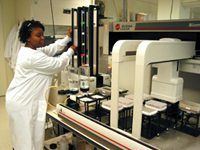
|
|
Keisha uses the Biomek FX robot to purify the plasmid DNA, which contains the gene of interest for research.
|
My typical workday involves cutting edge science, which I had previously only read about in magazines. At NISC, I come in contact with scientists who have revolutionized the way we look at sequencing genes for medical purposes. They are scientists who lead the Human Genome Project (http://www.genome.gov/10001772), and who have changed our view of how to analyze the three billion genes that make up humans.
I work in the production section. Our job is to produce deoxyribonucleic acid (or DNA) sequence data, which is eventually made available to the public. Scientists all over the world use the data for their own experiments. The production section is divided into two groups: the preparatory group and the sequence group. Depending on our bi-weekly schedule, I may be in either group.
Tasks in the Preparation Group:
- Place growth boxes containing growth media and cells into the incubator for overnight growth. We use Escherichia Coli (E. Coli) bacterial cells that contain a plasmid (http://www2.merriam-webster.com/cgi-bin/mwmednlm) with a gene of interest. The plasmid is a circular segment of Deoxyribonucleic Acid (or DNA, http://www2.merriam-webster.com/cgi-bin/mwmednlm) that can divide independently from the cell’s normal DNA. Plasmids are naturally present in bacteria, but they are used in research as a way to study genes of interest.
- Purify the plasmid from the E. Coli cells using a purification robot, called the Biomek FX
- Perform agarose gel analysis as a quality control on the purified plasmid DNA sample. This allows us to make sure the gene of interest is present and intact for further processing.
Tasks in the Sequence Group:
- Set-up and cleanup of DNA reactions
- Operate and maintain liquid transfer robotics and DNA sequencing instruments
- Purify the gene of interest from the plasmid and prepare the gene for sequencing the next day using various robots
Equipment I Use:
- Biomek FX – Automated robot that cleans and purifies the plasmid DNA from the E. Coli cells. The plasmid DNA contains the gene of interest for research purposes.
- Liquid Transfer Robots (the NX & Hamilton) – Robots that transfer our large batches of E. Coli cells into a lot of small test tubes. We use these samples as backups in case something goes wrong in the sequencing and it must be repeated.
- Sequencing Robots (Applied Biosystems Model 3730) – Robots that carryout the DNA sequencing reactions in multiple 384-well plates.
- Besides my production duties, I must also adhere to laboratory protocols, record results, and provide general laboratory support. General laboratory support includes, autoclaving glassware, sorting deliveries, and maintaining lab cleanliness.
An Environment of Teamwork
I attend weekly group meetings where the team captain gives the status of the preparation group or the sequencing group for that week. The team captain records and documents any deviations to the protocol, any breakdowns of the robots, and allows time for the group to discuss any concerns.
NISC is a group-oriented environment, so it is critical that I communicate with my team members about tasks for the day. By communicating with my co-workers, we are able to efficiently and effectively complete any project or scheduled work. When working in a group environment, you get to know your colleagues very well. I have become friends with many of them; and we socialize outside of the NISC environment.
Being able to multitask, being detailed oriented, and most importantly, being able to interact and communicate within a group makes me well suited to my work at NISC.
|
|
3. What I like best/least about my work...
|
Back to Top

|
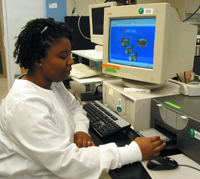
|
|
Keisha uses a spectrophotometer to determine the concentration of E. Coli cells in a batch of media.
|
What I like best about my work at NISC is being able to meet many important and famous scientists. I am able to be in the same environment with such great scientists as Francis Collins (http://www.genome.gov/10000779) and Eric Green (http://www.genome.gov/10000452). Every week a primary investigator or other institute scientist presents a video or gives a talk on a genetics topic. I have worked at other companies where there was no concern whether or not employees understood the company’s goals or the science behind the company’s products. That is why I appreciate the weekly meetings because they help me understand the science behind what I do. The talks update me on many ongoing projects at the institute. This is an environment where my career as a geneticist is able to grow.
I also love that NISC has so much diversity within the various groups. There are people here from Korea, Russia, Ukraine, Thailand, and many other countries around the world.
The easiest part of my job is interacting and communicating with my co-workers. I am a people person and I love to talk so it comes natural to work in a group environment.
What I like least about my work is not being able to follow protocol all the time. Sometimes, due to unforeseen circumstances, you must deviate from the protocol to account for a robot malfunction or because the incubator stopped in the middle of the night. Anytime we prepare reagents or troubleshoot problems with the equipment, we keep a record in a lab notebook. The most challenging aspect of my work is trying to get all of the scheduled work done in an allotted time, even when the robots or sequencing machines breakdown or samples do not come to our group in a reasonable amount of time.
In addition, there are some tasks that are necessary but not that fun to do, such as coordinating waste collection, labeling and disposal pick-up.
As in most research facilities, I see many women working at entry-level to mid-level management positions. I would like to see more women in higher-level positions. This would give other young women courage to pursue science as a career, knowing they can succeed.
|
|
4. My career goals...
|
Back to Top

|
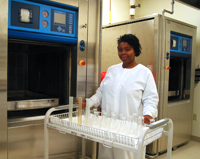
|
|
Keisha uses an autoclave (an industrial steam cleaner) to sterilize laboratory glassware.
|
My career goals are to obtain as much information about genomics, genetic counseling, and medical genetics as possible. I hope to return back to school and obtain a masters degree in genetic counseling. Before I worked at NISC, I was planning to attend graduate school but I was not sure what to choose for a major. Now that I have been able to learn about the many projects and discoveries in genetics, I have decided to pursue a career in genetic counseling. A genetic counselor’s career incorporates working with patients, as well as, working in a research lab. Both aspects appeal to me.
In 5-10 years I plan to have my degree in genetic counseling and I would like to work at the NIH as a genetic counselor helping people understand their genes and how medicine tailored to there genome could help them live a healthy lifestyle. I would also like to open my own clinic that will give lower income people access to free or low cost healthcare. After I have children, I may consider going back to school to obtain a Ph.D. in human genetics.
|
|
5. When I'm not working, I like to...
|
Back to Top

|
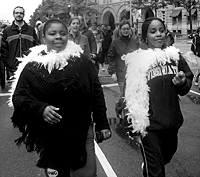
|
|
Keisha and her friend Tammy participating in the 2006 annual AIDS Walk in Washington, D.C.
|
When I’m not working, I like to scrapbook and go to the opera. I am a huge fan of operas, musicals, and anything dealing with the stage. My favorite venue is the Kennedy Center in Washington D.C. I enjoy living in this area because I can go to the Smithsonian or see the White House anytime I want. I love science and history, so being able to go to these places is a dream for me!
I am also in Sigma Gamma Rho (a great sorority), and Toastmasters International (a well-known international public speaking organization). Our division of the Toastmasters International has 10 clubs. The Web site for my club is http://bloodyorators.googlepages.com/. I also participate in the annual AIDS (Acquired Immune Deficiency Syndrome) Walk in Washington D.C. with some friends. Our group name is the "Walkamaniacs.”
I am not an athlete, so I don't play sports. However, my husband is a mixed martial arts fighter. I attend many of his competitions and have become well versed in the art of Muay Thai (also known as Thai Boxing). I love to travel and learn about other cultures, which is perfect because my husband is in Thailand at the moment for some competitions. Because he travels a lot, I often go with him and am able to visit many countries and learn about many cultures.
|
|
6. Choosing my own path...
|
Back to Top

|
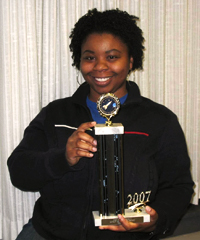
|
|
| |
Keisha holds the first place trophy she won in an Toastmasters International contest.
|
I am an African-American woman and many of my friends and family are surprised that I chose to major in genetics. Within my circle of family, friends and acquaintances, I am one of the few that has chosen a path in science or health. I am the only woman that is not working as a teacher, as a business professional, or as a housewife. I did not spend a lot of time researching or exploring my career choice. Once I took that AP biology class in high school, I knew genetics would keep my interest for many years.
Many of my friends in high school either had no clue or knew exactly what career they wanted to choose. I have always known that I wanted a career in science, but it wasn't until my last year of high school that I knew it would be genetics. My only advice to high school students is; “If you have many career choices in mind, don't be afraid to research and try them all, because the odds are, one of them will be your destiny.”
|
|
|
|
 |